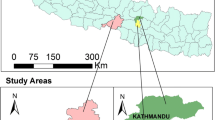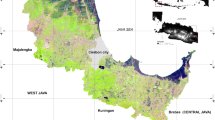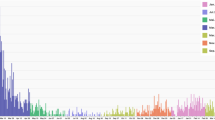Abstract
Th aim of this study is to investigate spatio-temporal trends of dengue vector breeding and epidemic (disease incidence) influenced by climatic factors. The spatio-temporal (low-, medium-, and high-intensity periods) evaluation of entomological and epidemiological investigations along with climatic factors like rainfall (RF), temperature (Tmax), relative humidity (RH), and larval indexing was conducted to develop correlations in the area of Lahore, Pakistan. The vector abundance and disease transmission trend was geo-tagged for spatial insight. The sufficient rainfall events and optimum temperature and relative humidity supported dengue vector breeding with high larval indices for water-related containers (27–37%). Among temporal analysis, the high-intensity period exponentially projected disease incidence followed by post-rainfall impacts. The high larval incidence that was observed in early high-intensity periods effected the dengue incidence. The disease incidence had a strong association with RF (r = 0.940, α = 0.01). The vector larva occurrence (r = 0.017, α = 0.05) influenced the disease incidence. Similarly, RH (r = 0.674, α = 0.05) and average Tmax (r = 0.307, α = 0.05) also induced impact on the disease incidence. In this study, the vulnerability to dengue fever highly correlates with meteorological factors during high-intensity period. It provides area-specific understanding of vector behavior, key containers, and seasonal patterns of dengue vector breeding and disease transmission which is essential for preparing an effective prevention plan against the vector.
















Similar content being viewed by others
References
Arunachalam, N., Tana, S., Espino, F., Kittayapong, P., Abeyewickrem, W., Wai, K. T., Tyagi, B. K., Kroeger, A., Sommerfeld, J., & Petzold, M. (2010). Eco-bio-social determinants of dengue vector breeding: a multicountry study in urban and periurban Asia. Bulletin of the World Health Organization, 88(3), 173–184.
Bandyopadhyay, S., & Skoufias, E. (2015). Rainfall variability, occupational choice, and welfare in rural Bangladesh. Review of Economics of the Household, 13(3), 589–634.
Banu, S., Hu, W., Guo, Y., Hurst, C., & Tong, S. (2014). Projecting the impact of climate change on dengue transmission in Dhaka, Bangladesh. Environment International, 63, 137–142.
Bennett, S. N., Drummond, A. J., Kapan, D. D., Suchard, M. A., Munoz-Jordan, J. L., Pybus, O. G., Holmes, E. C., & Gubler, D. J. (2010). Epidemic dynamics revealed in dengue evolution. Molecular Biology and Evolution, 27(4), 811–818.
Bouzid, M., Brainard, J., Hooper, L., & Hunter, P. R. (2016). Public health interventions for Aedes control in the time of Zikavirus—a meta-review on effectiveness of vector control strategies. PLoS Neglected Tropical Diseases, 10(12), e0005176.
Chen, S. C., Liao, C. M., Chio, C. P., Chou, H. H., You, S. H., & Cheng, Y. H. (2010). Lagged temperature effect with mosquito transmission potential explains dengue variability in southern Taiwan: insights from a statistical analysis. Science of the Total Environment, 408(19), 4069–4075.
Cheong, Y. L., Burkart, K., Leitão, P. J., & Lakes, T. (2013). Assessing weather effects on dengue disease in Malaysia. International Journal of Environmental Research and Public Health, 10(12), 6319–6334.
Cheong, Y. L., Leitão, P. J., & Lakes, T. (2014). Assessment of land use factors associated with dengue cases in Malaysia using boosted regression trees. Spatial and spatio-temporal epidemiology, 10, 75–84.
Dhimal, M., Gautam, I., Joshi, H. D., O’Hara, R. B., Ahrens, B., & Kuch, U. (2015). Risk factors for the presence of chikungunya and dengue vectors (Aedes aegypti and Aedes albopictus), their altitudinal distribution and climatic determinants of their abundance in central Nepal. PLoS Neglected Tropical Diseases, 9(3), e0003545.
Dieng, H., Hassan, A. A., Satho, T., Miake, F., Salmah, M. R. C., & AbuBakar, S. (2011). Insecticide susceptibility of the dengue vector Aedes aegypti (Diptera: Culicidae) in Makkah City, Saudi Arabia. Asian Pacific Journal of Tropical Disease, 1(2), 94–99.
Dom, N. C., Ahmad, A. H., Ishak, A. R., & Ismail, R. (2013). Assessing the risk of dengue fever based on the epidemiological, environmental and entomological variables. Procedia-Social and Behavioral Sciences, 105, 183–194.
Estallo, E. L., Carbajo, A. E., Grech, M. G., Frías-Céspedes, M., López, L., Lanfri, M. A., Ludueña-Almeida, F. F., & Almirón, W. R. (2014). Spatio-temporal dynamics of dengue 2009 outbreak in Córdoba City, Argentina. Acta Tropica, 136, 129–136.
Gama, Z. P., & Nakagoshi, N. (2013). Climatic variability and dengue haemaorrhagic fever incidence in Nganjuk district, East Java, Indonesia. Acta Biologica Malaysiana, 2(1), 31–39.
Giriyanna, G., Sridevi, K., Madhusudan, M., & Ravi, K. (2015). Awareness regarding dengue fever among the link workers of urban health centres of Bengaluru City-South India. Asian Pacific Journal of Tropical Disease, 5, S42–S44.
Gubler, D. J. (2011). Dengue, Urbanization and Globalization: The Unholy Trinity of the 21 (st) Century. Tropical Medicine and Health, 39, 3–11. doi:10.2149/tmh.2011-S05.
Harinder, S., & Sukhmeet, M. (2014). A study of larval indices of Aedes and the risk for dengue outbreak. Sch. Acad. J. Biosci., 2(8), 544–547.
Honório, N. A., Codeço, C. T., Alves, F. C., Magalhães, M. A. F. M., & Lourenço-de-Oliveira, R. (2009). Temporal distribution of Aedes aegypti in different districts of Rio de Janeiro, Brazil, measured by two types of traps. Journal of Medical Entomology, 46(5), 1001–1014.
Mohiddin, A., Jaal, Z., Lasim, A. M., Dieng, H., & Zuharah, W. F. (2015). Assessing dengue outbreak areas using vector surveillance in north east district, Penang Island, Malaysia. Asian Pacific Journal of Tropical Disease, 5(11), 869–876.
Mohiddin, A., Lasim, A. M., & Zuharah, W. F. (2016). Susceptibility of Aedes albopictus from dengue outbreak areas to temephos and Bacillus thuringiensis subsp. israelensis. Asian Pacific Journal of Tropical Biomedicine, 6(4), 295–300.
Naqvi, S. A. A., Kazmi, S. J. H., Shaikh, S., & Akram, M. (2015). Evaluation of prevalence patterns of dengue fever in Lahore District through geo-spatial techniques. Journal of Basic & Applied Sciences, 11, 20.
Padmanabha, H., Correa, F., Legros, M., Nijhout, H. F., Lord, C., & Lounibos, L. P. (2012). An eco-physiological model of the impact of temperature on Aedes aegypti life history traits. Journal of Insect Physiology, 58(12), 1597–1608.
Ramasamy, R., Surendran, S. N., Jude, P. J., Dharshini, S., & Vinobaba, M. (2011). Larval development of Aedes aegypti and Aedes albopictus in peri-urban brackish water and its implications for transmission of arboviral diseases. PLoS Neglected Tropical Diseases, 5(11), e1369.
Rodriguez-Roche, R., & Gould, E. A. (2013). Understanding the dengue viruses and progress towards their control. BioMed Research International. doi:10.1155/2013/690835.
Sarfraz, M. S., Tripathi, N. K., Tipdecho, T., Thongbu, T., Kerdthong, P., & Souris, M. (2012). Analyzing the spatio-temporal relationship between dengue vector larval density and land-use using factor analysis and spatial ring mapping. BMC Public Health, 12(1), 853.
Sutherst, R. W. (2004). Global change and human vulnerability to vector-borne diseases. Clinical Microbiology Reviews, 17(1), 136–173.
Tran, A., L’Ambert, G., Lacour, G., Benoît, R., Demarchi, M., Cros, M., Cailly, P., Aubry-Kientz, M., Balenghien, T., & Ezanno, P. (2013). A rainfall-and temperature-driven abundance model for Aedes albopictus populations. International Journal of Environmental Research and Public Health, 10(5), 1698–1719.
Tsai, C. T., Sung, F. C., Chen, P. S., & Lin, S. C. (2012). Exploring the spatial and temporal relationships between mosquito population dynamics and dengue outbreaks based on climatic factors. Stochastic Environmental Research and Risk Assessment, 26(5), 671–680.
Urdaneta-Marquez, L., & Failloux, A. B. (2011). Population genetic structure of Aedes aegypti, the principal vector of dengue viruses. Infection, Genetics and Evolution, 11(2), 253–261.
Wongkoon, S., Jaroensutasinee, M., & Jaroensutasinee, K. (2013). Distribution, seasonal variation & dengue transmission prediction in Sisaket, Thailand. The Indian Journal of Medical Research, 138(3), 347.
Wu, P. C., Guo, H. R., Lung, S. C., Lin, C. Y., & Su, H. J. (2007). Weather as an effective predictor for occurrence of dengue fever in Taiwan. Acta Tropica, 103(1), 50–57.
Wu, P. C., Lay, J. G., Guo, H. R., Lin, C. Y., Lung, S. C., & Su, H. J. (2009). Higher temperature and urbanization affect the spatial patterns of dengue fever transmission in subtropical Taiwan. Science of the Total Environment, 407(7), 2224–2233.
Wu, X., Lu, Y., Zhou, S., Chen, L., & Xu, B. (2016). Impact of climate change on human infectious diseases: empirical evidence and human adaptation. Environment International, 86, 14–23.
Acknowledgments
The authors would like to thank the team of Dengue Vector Control and Prevention Unit Data Gunj Bukhsh Town Lahore for all of field assistance during this project. We also thank the Director Punjab Information Technology Board for providing the meteorological health data entries.
Author information
Authors and Affiliations
Corresponding author
Ethics declarations
Conflict of interest
We declare that we have no conflict of interest.
Human and animal rights and informed consent
This article does not contain any studies with human participants performed by any of the authors.
Rights and permissions
About this article
Cite this article
Malik, A., Yasar, A., Tabinda, A.B. et al. Assessing spatio-temporal trend of vector breeding and dengue fever incidence in association with meteorological conditions. Environ Monit Assess 189, 189 (2017). https://doi.org/10.1007/s10661-017-5902-x
Received:
Accepted:
Published:
DOI: https://doi.org/10.1007/s10661-017-5902-x




